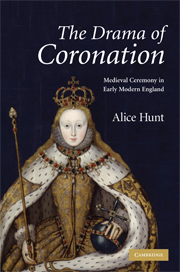Book contents
- Frontmatter
- Contents
- Preface
- Note on style and dates
- List of abbreviations
- Introduction: the ‘idol’ ceremony of coronation
- Chapter 1 Why crown a king? Henry VIII and the medieval coronation
- Chapter 2 ‘Come my love thou shalbe crowned’: the drama of Anne Boleyn's coronation
- Chapter 3 ‘But a ceremony’: Edward VI's reformed coronation and John Bale's King Johan
- Chapter 4 ‘He hath sent Marye our soveraigne and Quene’: England's first queen and Respublica
- Chapter 5 ‘A stage wherin was shewed the wonderfull spectacle’: representing Elizabeth I's coronation
- Epilogue: ‘Presume not that I am the thing I was’
- Notes
- Bibliography
- Index
Chapter 3 - ‘But a ceremony’: Edward VI's reformed coronation and John Bale's King Johan
Published online by Cambridge University Press: 22 September 2009
- Frontmatter
- Contents
- Preface
- Note on style and dates
- List of abbreviations
- Introduction: the ‘idol’ ceremony of coronation
- Chapter 1 Why crown a king? Henry VIII and the medieval coronation
- Chapter 2 ‘Come my love thou shalbe crowned’: the drama of Anne Boleyn's coronation
- Chapter 3 ‘But a ceremony’: Edward VI's reformed coronation and John Bale's King Johan
- Chapter 4 ‘He hath sent Marye our soveraigne and Quene’: England's first queen and Respublica
- Chapter 5 ‘A stage wherin was shewed the wonderfull spectacle’: representing Elizabeth I's coronation
- Epilogue: ‘Presume not that I am the thing I was’
- Notes
- Bibliography
- Index
Summary
On 20 February 1547, Edward VI was anointed and crowned by Thomas Cranmer in Westminster Abbey. He was nine years old. On the following Tuesday, Shrove Tuesday, plays and masques were performed as part of the traditional post-coronation entertainments. The Revels' accounts record payments for the ‘newe making and altering of Sundry maskes, and garmentes for players agenste the Coronacion of our soveraigne lorde Edward the Sixth’. Players included children and gentlemen of the Chapel Royal, and even King Edward himself. No further details about the play texts are extant, but the costumes and props itemised are highly suggestive: the plays featured cardinals, priests, popes and monarchs. Costumes included orders for ‘Silk lace and Tasselles for Cardynalles hattes for players’, ‘the making of Crownes & Crosse for the poope in playe’ and ‘iii Cappes of Crimson & black satten for prestes in pley’.
Edward VI's coronation was subjected to substantial revision and interpretation. He was the first monarch to be formally proclaimed king prior to his coronation and the Recognition and the oath were redrafted by his Privy Council. Archbishop Cranmer delivered an address before he anointed Edward in which he declared that the ‘solemn rites of coronation have their ends and utility; yet neither direct force or necessity’ and that ‘the oil, if added, is but a ceremony’. The Privy Council's revisions to Edward's ceremony and Cranmer's notorious sermon transformed the sacred rite into a type of drama, albeit a necessary one.
- Type
- Chapter
- Information
- The Drama of CoronationMedieval Ceremony in Early Modern England, pp. 77 - 110Publisher: Cambridge University PressPrint publication year: 2008

